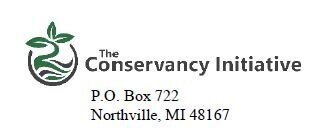On the evening of August 4th, the Arbor Hills Landfill reported a leachate spill into Johnson Creek using EGLE’s Pollution Emergency Alert System (PEAS). The Conservancy Initiative has obtained the incident reports submitted by GFL and documents from the EGLE inspection which occurred immediately following the incident. We will attach pertinent copies of the reports, but we caution that they can be confusing and probably won’t leave an accurate impression of how significant this event was. We will provide a summary of the spill event including our suggestions for the follow-up which is required.
Summary of Event (In plain English)
A rain event on August 4th resulted in a mudslide on the south side of the landfill. Mud, silt, and stormwater runoff rendered a leachate collection and pumping station inoperable (the mudslide partially buried some of the equipment and plugged the leachate pumps). When the leachate stopped being pumped, it overflowed the collection sump and entered a stormwater swale which discharged to Johnson Creek. The event occurred at 10 PM on the evening of August 4th but full-fledged response efforts were hampered by the continuing storm, lack of personnel at the site, and darkness.
The next morning, more resources were added to the spill response, and normal leachate collection and pumping operations were eventually restored, but not before an unknown volume of leachate entered the stormwater collection system and will eventually reach Johnson Creek. EGLE ordered GFL to take water samples of the stormwater pond and stormwater runoff being discharged to Johnson Creek to document the extent of the impact on Johnson creek. [This should be a standard operating procedure. If an event occurs which threatens the discharge to Johnson Creek, sampling must begin immediately and continue until the impact or threat of impact has ceased.]
Here are the most significant test results:
PFOS concentrations were more than 100 times the allowable levels which indicate the spill is having a significant impact on Johnson Creek. Ammonia levels were elevated as were other contaminants. Only a very limited number of parameters were tested, but several other results (Total Dissolved Solids, Chemical Oxygen Demand, and Chlorides) appeared elevated, but we did not have a reference to compare with those results.
The Conservancy Initiative expects EGLE to issue a violation notice for this incident and must require meaningful corrective and preventative actions to be put in place to prevent a similar incident. The preventative actions should include regular testing of the stormwater discharge to Johnson Creek to detect potential spills. The Conservancy Initiative has been advocating for periodic testing of the stormwater runoff and this is another example of why it is needed. Every sample analyzed of the stormwater discharged from Arbor Hills since 2020, which we are aware of, has exceeded applicable PFOS Water Quality Standards.
Below are additional Questions or suggestions that will be discussed with EGLE.
The landfill must be prepared for these types of events. It appears an earthen diversionary berm was overwhelmed. Has the berm been fortified? Should it be a cement structure?
Do the Leachate pumps have a back-up in the event of a power failure?
Sampling of the stormwater outfall should be automatic following a spill event. GLF should not need to be ordered to take samples once they have identified a spill. Sampling of the stormwater discharge should continue until the test results indicate the impact has been corrected.
Is GFL continuing to sample the stormwater outfall? EGLE should reinforce this Standard Operating Procedure with GFL.
Remediation of impacted soils should begin immediately to prevent impacts during future rain events. Verification testing must be performed to document all impacted soils have been removed.



